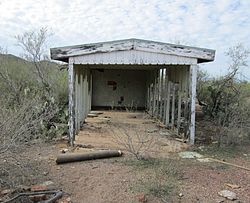Silver Bell, Arizona | |
|---|---|
 A ruin in Silver Bell. | |
| Coordinates: 32°23′05″N111°29′56″W / 32.38472°N 111.49889°W | |
| Country | United States |
| State | Arizona |
| County | Pima |
| Time zone | UTC-7 (MST (no DST)) |
| Post Office opened | August 18, 1904 |
Silver Bell is a ghost town in the Silver Bell Mountains in Pima County, Arizona, United States. The name "Silver Bell" refers to a more recent ghost town, which was established in 1954 and abandoned in 1984. The original town, established in 1904, was named "Silverbell" and abandoned in the early 1930s. [1] [2] Both towns were utilized and later abandoned due to the mining of copper in the area.
Contents
According to James E. Sherman's Ghost Towns of Arizona, Silverbell was "one of the most renowned mining camps in the Southwest," and was also described as "the Hell-hole of Arizona." Today nothing remains of the town other than a cemetery. [3]
















